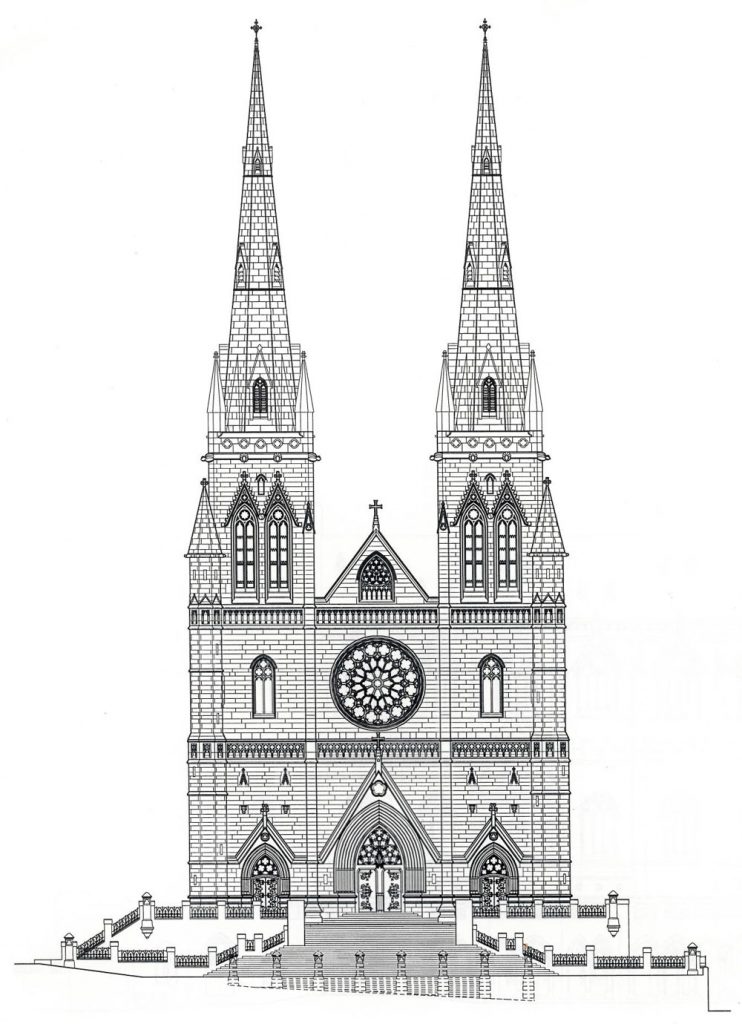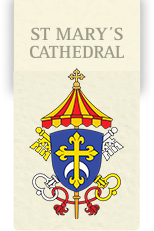Architecture – A church to impress
 St Mary’s Cathedral is the spiritual home of Sydney’s Catholic community. It is the seat of the Archbishop of Sydney and stands on the site of the first Catholic Chapel in Australia.
St Mary’s Cathedral is the spiritual home of Sydney’s Catholic community. It is the seat of the Archbishop of Sydney and stands on the site of the first Catholic Chapel in Australia.
Constructed in local sandstone, the ‘Gothic Revival’ style of its architecture pays respect to the great medieval cathedrals of Europe. St Mary’s is not only a great legacy from the past; but also it is a vital part of the present spiritual and cultural life of the city and the nation.
Architect William Wardell, a convert to Catholicism, was born in 1823, and as an architect in England had become an accomplished practitioner of the Gothic Revival style of architecture.
He came to the Australian colonies in 1858, living and working in Melbourne. Wardell designed several important buildings in Melbourne, including St Patrick’s Cathedral and in Sydney the University of Sydney’s St John’s College stands as further testimony to his skill.
The driving force for the new cathedral, Archbishop Polding wrote to Wardell, “… And now for the design itself of our new cathedral. I have little to say beyond this, that I go to the architect of St John’s College of the University of Sydney to ask him for something that shall again be an honour to himself and the Catholics of the diocese. I leave all to you and your own inspiration in the matter. (Letter of 10 October, 1865).
Constructed of dressed Sydney sandstone, St Mary’s stretches 107 metres in length and the central tower rises to 46 metres. When the spires were built in 2000, the Cathedral soared to 75 metres.
The first stage of the cathedral, the northern section, was built between 1866 and 1900. Stage two, the southern section was completed between 1912 and 1928.
St Mary’s is designed principally in the Geometric Decorated style of Gothic which first evolved around the 13th century. It is not a copy of a particular medieval cathedral, but is a unique design, drawing on certain elements of its medieval forbears. In keeping with many medieval English cathedrals, there is a strong emphasis on the length-wise dimension of the building, while viewed from the side and the front façade, with twin towers flanking a rose window, it is more reminiscent of a typical French cathedral.
The customary east-west orientation of cathedrals was abandoned by Wardell, probably because the fall of the land together with the fact that the great length of the building would have made such an orientation impractical. Instead of being at the eastern end, therefore, the Sanctuary of St Mary’s is located at the northern end of the plan, with the main façade and principal entrance at the southern end.
Even so, the slope of the land and an apparent error in the ‘starting point’ of the building on the site necessitated the addition of a flight of more than 30 steps to the front of the building by the architects, Hennessey & Hennessey, who took responsibility for the completion of the Cathedral to Wardell’s design after his death in 1899.
A visitor to St Mary’s will see many features on the outside of the building: the flying buttresses of the chancel and nave; the canopies and statues in the northern gable, the text of the Ave Maria and other invocations carved high up on the walls; the many carved saintly heads which gaze benignly down, and, way up on the towers and turrets, the more menacing figures of the gargoyles.
Moving inside the church through the main doors, the eye is drawn forward, along the length of the nave, toward the white pinnacles of the High Altar Screen, and the rich colours of the Great North Window beyond.
The columns of the main arcade are of the same warm sandstone as the exterior and interior walls, which has also been used in the vaulted ceilings of the side aisles and chapels. The ceiling of the chancel is vaulted in timber, and the roof of the nave is of double hammerbeam construction. Looking up towards the ceilings, the visitor will notice many more of the saintly heads first seen on the outside walls.
As is usual in Gothic cathedrals, St Mary’s has three levels of arched openings along its length: the high arches of the main arcade, the gallery-like openings of the triforium, and the windows of the clerestory.
At intervals along the nave walls, triple archways lead to the confessional rooms. Small columns of Moruya granite divide these openings. On the eastern side of the Nave, a larger archway forms the entrance to the Baptistery, with its apse-like form and ornate ceiling. Stained glass windows pierce the walls of the nave, transepts and chancel.
In the western nave aisle, stairs lead down to the Crypt, remarkable for the beauty of its floor of terrazzo mosaic. In vaults beneath the floor of the Crypt lie the mortal remains of the deceased Archbishops of Sydney and pioneer priests such as Fr John Joseph Therry, the founder of St Mary’s.

